The Importance of Conditioned Stimuli in Cigarette and E-Cigarette Craving Reduction by E-Cigarettes
Abstract
:1. Introduction
2. Materials and Methods
2.1. Participants
2.2. Materials and Equipment
2.2.1. CO Measurement
2.2.2. Electronic Cigarettes
2.2.3. Unipod and Blindfold
2.2.4. Questionnaires
2.3. Procedure
2.3.1. First Session
2.3.2. Second Session
3. Results
3.1. Statistical Analyses
3.2. General Characteristics
3.3. CO Measures
3.4. Tobacco Craving Questionnaire
3.4.1. Cigarette Craving (TCQ)
3.4.2. E-Cig Craving (e-TCQ)
3.5. Visual Analogue Scales
3.5.1. Cigarette Craving (VAS)
3.5.2. E-Cig Craving (VAS)
4. Discussion
5. Conclusions
Acknowledgments
Author Contributions
Conflicts of Interest
References
- Hughes, J.R.; Keely, J.; Naud, S. Shape of the relapse curve and long-term abstinence among untreated smokers. Addiction 2004, 99, 29–38. [Google Scholar] [CrossRef] [PubMed]
- Schlam, T.R.; Baker, T.B. Interventions for tobacco smoking. Annu. Rev. Clin. Psychol. 2013, 9, 675–702. [Google Scholar] [CrossRef] [PubMed]
- Polosa, R.; Rodu, B.; Caponetto, P.; Maglia, M.; Raciti, C. A fresh look at tobacco harm reduction: The case for the electronic cigarette. Harm Reduct. J. 2013, 10, 1–19. [Google Scholar] [CrossRef] [PubMed]
- Rodu, B. The scientific foundation for tobacco harm reduction, 2006–2011. Harm Reduct. J. 2011, 8. [Google Scholar] [CrossRef] [PubMed]
- Rodu, B.; Godshall, W.T. Tobacco harm reduction: An alternative cessation strategy for inveterate smokers. Harm Reduct. J. 2006, 3. [Google Scholar] [CrossRef] [PubMed]
- Dawkins, L. Why is it so hard to quit smoking? Psychologist 2013, 26, 332–335. [Google Scholar]
- Collins, A.C. An analysis of the addiction liability of nicotine. Adv. Alcohol Subst. Abuse 1990, 9, 83–101. [Google Scholar] [CrossRef] [PubMed]
- Risner, M.E.; Goldberg, S.R. A comparison of nicotine and cocaine self-administration in the dog fixed-ratio and progressive-ratio schedules of intravenous drug infusion. J. Pharmacol. Exp. Ther. 1983, 224, 319–326. [Google Scholar] [PubMed]
- Frenk, H.; Dar, R. If the data contradict the theory, throw out the data: Nicotine addiction in the 2010 report of the surgeon general. Harm Reduct. J. 2011, 19. [Google Scholar] [CrossRef] [PubMed]
- Rose, J.E.; Salley, A.; Behm, F.M.; Bates, J.E.; Westman, E.C. Reinforcing effects of nicotine and non-nicotine components of cigarette smoke. Psychopharmacology 2010, 210, 1–12. [Google Scholar] [CrossRef] [PubMed]
- Rose, J.E. Nicotine and nonnicotine factors in cigarette addiction. Psychopharmacology 2006, 184, 274–285. [Google Scholar] [CrossRef] [PubMed]
- Rose, J.E.; Behm, F.M.; Westman, E.C.; Bates, J.E.; Salley, A. Pharmacologic and sensorimotor components of satiation in cigarette smoking. Pharmacol. Biochem. Behav. 2003, 76, 243–250. [Google Scholar] [CrossRef] [PubMed]
- Rose, J.E.; Behm, F.M.; Westman, E.C.; Johnson, M. Dissociating nicotine and non-nicotine components of cigarette smoking. Pharmacol. Biochem. Behav. 2000, 67, 71–81. [Google Scholar] [CrossRef]
- Markou, A.; Paterson, N.E. Multiple motivational forces contribute to nicotine dependence. Nebr. Symp. Motiv. 2009, 55, 65–89. [Google Scholar] [PubMed]
- Caggiula, R.A.; Donny, E.C.; Palmatier, M.I.; Liu, X.; Chaudri, N.; Sved, A.F. The role of nicotine in smoking: A dual-reinforcement model. Nebr. Symp. Motiv. 2009, 55. [Google Scholar] [CrossRef]
- Bullen, C.; McRobbie, H.; Thornley, S.; Glover, M.; Lin, R.; Laugesen, M. Effect of an electronic nicotine delivery device (e-cigarette) on desire to smoke and withdrawal, user preferences and nicotine delivery: Randomised cross-over trial. Tob. Control 2000, 19, 98–103. [Google Scholar] [CrossRef] [PubMed]
- Farsalinos, K.E.; Spyrou, A.; Tsimopoulou, K.; Stefopoulos, C.; Romagna, G.; Voudris, V. Nicotine absorption from electronic cigarette use: Comparison between first and new-generation devices. Sci. Rep. 2014, 4. [Google Scholar] [CrossRef] [PubMed]
- Talih, S.; Balhas, Z.; Eissenberg, T.; Salman, R.; Karaoghlanian, N.; El Hellani, A.; Baalbaki, R.; Saliba, N.; Shihadeh, A. Effects of user puff topography, device voltage, and liquid nicotine concentration on electronic cigarette nicotine yield: Measurements and model predictions. Nicotine Tob. Res. 2015, 17, 150–157. [Google Scholar] [CrossRef] [PubMed]
- Lopez, A.A.; Hiler, M.M.; Soule, E.K.; Ramôa, C.P.; Karaoghlanian, N.V.; Lipato, T.; Breland, A.B.; Shihadeh, A.L.; Eissenberg, T. Effects of electronic cigarette liquid nicotine concentration on plasma nicotine and puff topography in tobacco cigarette smokers: A preliminary report. Nicotine Tob. Res. 2016, 18, 720–723. [Google Scholar] [CrossRef] [PubMed]
- Ramôa, C.P.; Hiler, M.M.; Spindle, T.R.; Lopez, A.A.; Karaoghlanian, N.; Lipato, T.; Breland, A.B.; Shihadeh, A.; Eissenberg, T. Electronic cigarette nicotine delivery can exceed that of combustible cigarettes: A preliminary report. Tob. Control 2016, 25, 6–9. [Google Scholar] [CrossRef] [PubMed]
- Vansickel, A.R.; Cobb, C.O.; Weaver, M.F.; Eissenberg, T.E. A clinical laboratory model for evaluating the acute effects of electronic “cigarettes”: Nicotine delivery profile and cardiovascular and subjective effects. Cancer Epidemiol. Biomark. Prev. 2010, 19, 1945–1953. [Google Scholar] [CrossRef] [PubMed]
- Dawkins, L.; Turner, J.; Hasna, S.; Soar, K. The electronic-cigarette: Effects on desire to smoke, withdrawal symptoms and cognition. Addict. Behav. 2012, 37, 970–973. [Google Scholar] [CrossRef] [PubMed]
- Dawkins, L.; Corcoran, O. Acute electronic cigarette use: Nicotine delivery and subjective effects in regular users. Psychopharmacology 2013, 231, 401–407. [Google Scholar] [CrossRef] [PubMed]
- Adriaens, K.; Van Gucht, D.; Declerk, P.; Baeyens, F. Effectiveness of the electronic cigarette: An 8-week Flemish study with six-month follow-up on smoking reduction, craving and experience benefits and complaints. Int. J. Environ. Res. Public Health 2014, 11, 11220–11248. [Google Scholar] [CrossRef] [PubMed] [Green Version]
- Dawkins, L.; Munafo, M.; Christoforou, G.; Olumegbon, N.; Soar, K. The effects of e-cigarette visual appearance on craving and withdrawal symptoms in abstinent smokers. Psychol. Addict. Behav. 2016, 30, 101–105. [Google Scholar] [CrossRef] [PubMed]
- Audrain-McGovern, J.; Strasser, A.A.; Wileyto, E.P. The impact of flavoring on the rewarding and reinforcing value of e-cigarettes with nicotine among young adult smokers. Drug Alcohol Depend. 2016, 1, 263–267. [Google Scholar] [CrossRef] [PubMed]
- Goldenson, N.I.; Kirkpatrick, M.G.; Barrington-Trimis, J.L.; Pang, R.D.; McBeth, J.F.; Pentz, M.A.; Samet, J.M.; Leventhal, A.M. Effects of sweet flavorings and nicotine on the appeal and sensory properties of e-cigarettes among young adult vapers: Application of a novel methodology. Drug Alcohol Depend. 2016, 168, 176–180. [Google Scholar] [CrossRef] [PubMed]
- Bedfont Scientific Ltd. piCO + Smokerlyzer ®: Operating Manual; Kent: Tustin, CA, USA, 2011. [Google Scholar]
- Fagerström, K. Determinants of tobacco use and renaming the FTND to the Fagerstrom Test for Cigarette Dependence. Nicotine Tob. Res. 2012, 14, 75–78. [Google Scholar] [CrossRef] [PubMed]
- Singleton, E.G.; Anderson, L.M.; Heishman, S.J. Reliability and validity of the tobacco craving questionnaire and validation of a craving-induction procedure using multiple measures of craving and mood. Addiction 2003, 98, 1537–1546. [Google Scholar] [CrossRef] [PubMed]
- Heishman, S.J.; Singleton, E.G.; Moolchan, E.T. Tobacco craving questionnaire: Reliability and validity of a new multifactorial instrument. Nicotine Tob. Res. 2003, 5, 645–654. [Google Scholar] [PubMed]
- R Core Team. R: A Language and Environment for Statistical Computing; R Foundation for Statistical Computing: Vienna, Austria, 2016; Available online: https://www.R-project.org/ (accessed on 19 October 2016).
- Bates, D.; Maechler, M.; Bolker, B.; Walker, S. Fitting linear mixed-effects models using LME4. J. Stat. Softw. 2015, 67, 1–48. [Google Scholar] [CrossRef]
- Kuznetsova, A.; Brockhoff, P.B.; Christensen, R.H.B. Lmertest: Tests in Linear Mixed Effects Models. R Package Version 2.0-32, 2016. Available online: https://www.CRAN.R-project.org/package=lmerTest (accessed on 19 October 2016).
- Wickham, H. The split-apply-combine strategy for data analysis. J. Stat. Softw. 2011, 40, 1–29. [Google Scholar] [CrossRef]
- Wickham, H. Reshaping data with the reshape package. J. Stat. Softw. 2007, 21, 1–20. [Google Scholar] [CrossRef]
- Polosa, R.; Benowitz, N.L. Treatment of nicotine addiction: Present therapeutic options and pipeline developments. Trends Pharmacol. Sci. 2011, 32, 281–289. [Google Scholar] [CrossRef] [PubMed]
- Naqvi, N.H.; Bechara, A. The airway sensory impact of nicotine contributes to the conditioned reinforcing effects of individual puffs from cigarettes. Pharmacol. Biochem. Behav. 2005, 81, 821–829. [Google Scholar] [CrossRef] [PubMed]
- Dautzenberg, B.; Scheck, A.; Garelik, D.; Kayal, C.; Dautzenberg, D.M. Satisfactory throat hit is needed to switch from toboacco to e cigarettes: A lesson from an e liquid blind test. Tob. Prev. Cessat. 2016, 2. [Google Scholar] [CrossRef]
- McQueen, A.; Tower, S.; Sumner, W. Interviews with “vapers”: Implications for future research with electronic cigarettes. Nicotine Tob. Res. 2011, 13, 860–867. [Google Scholar] [CrossRef] [PubMed]
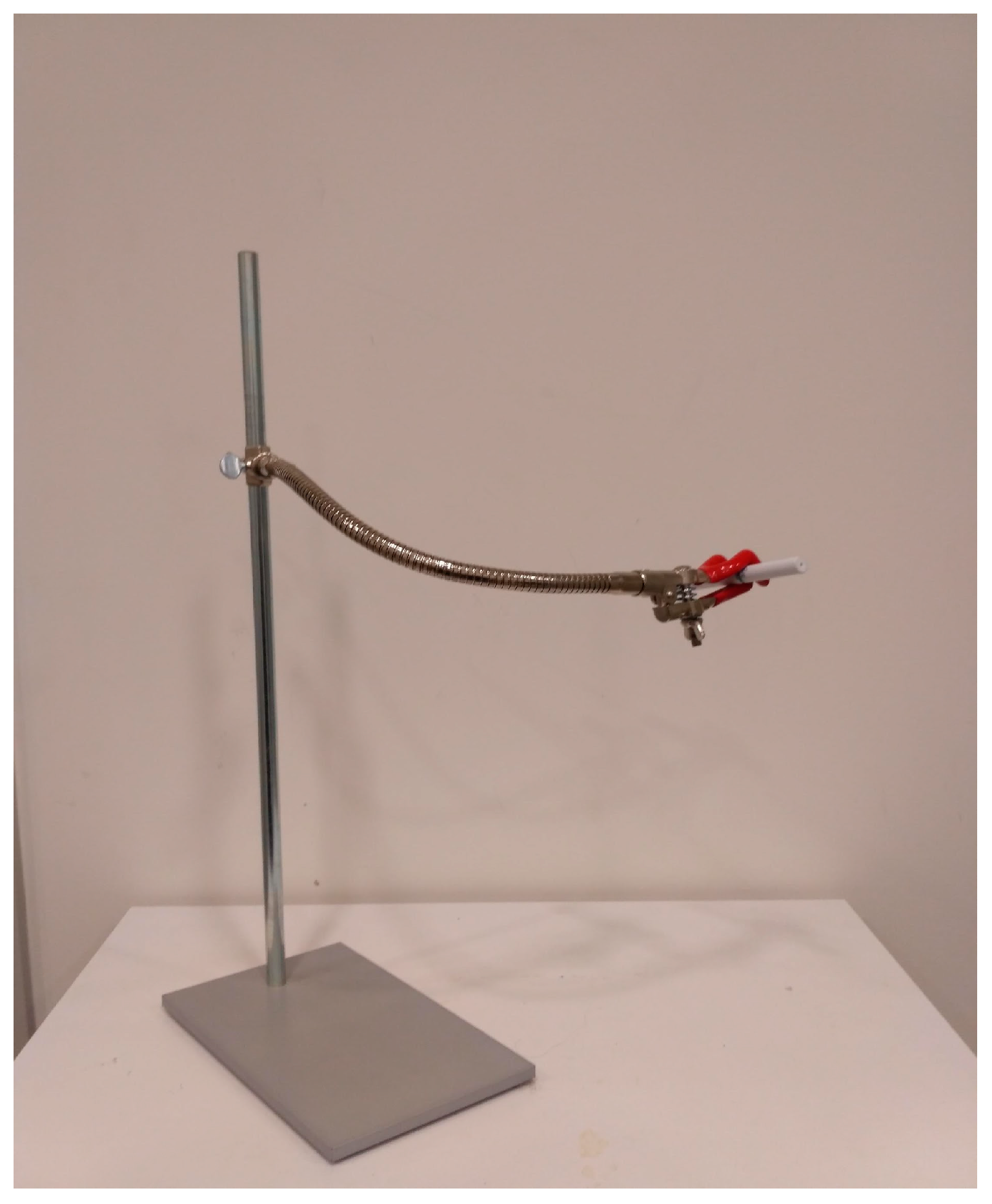
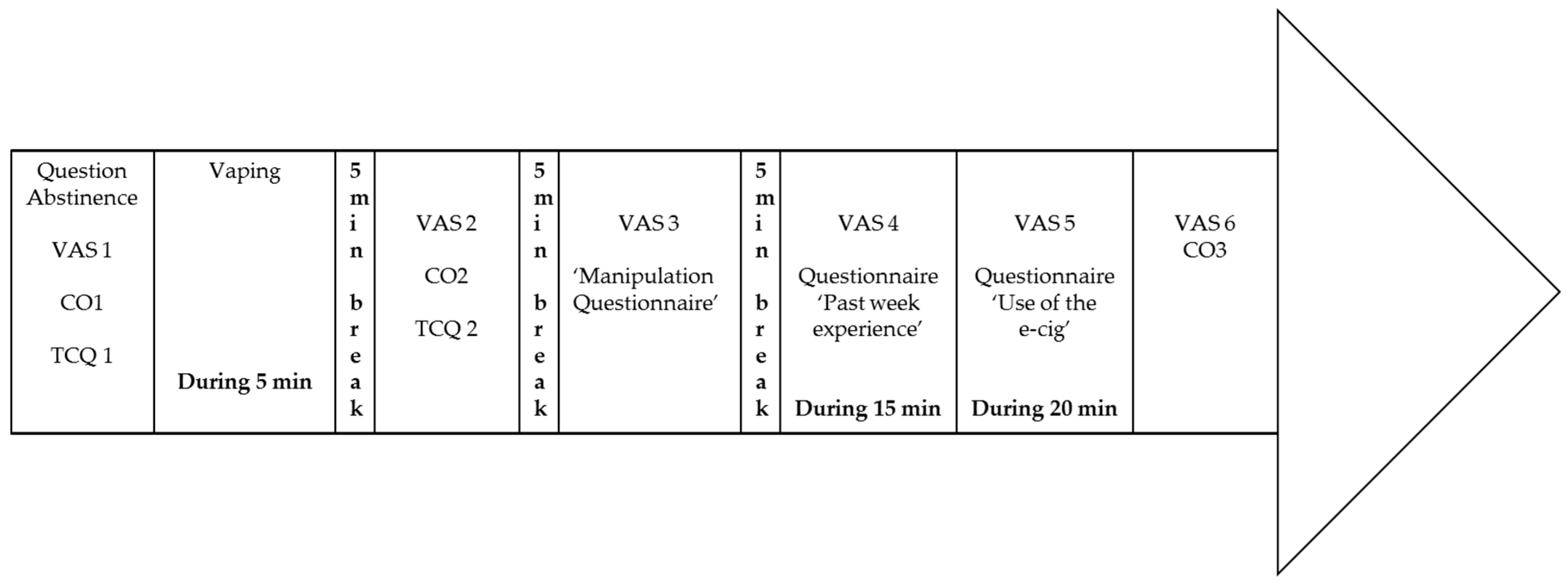
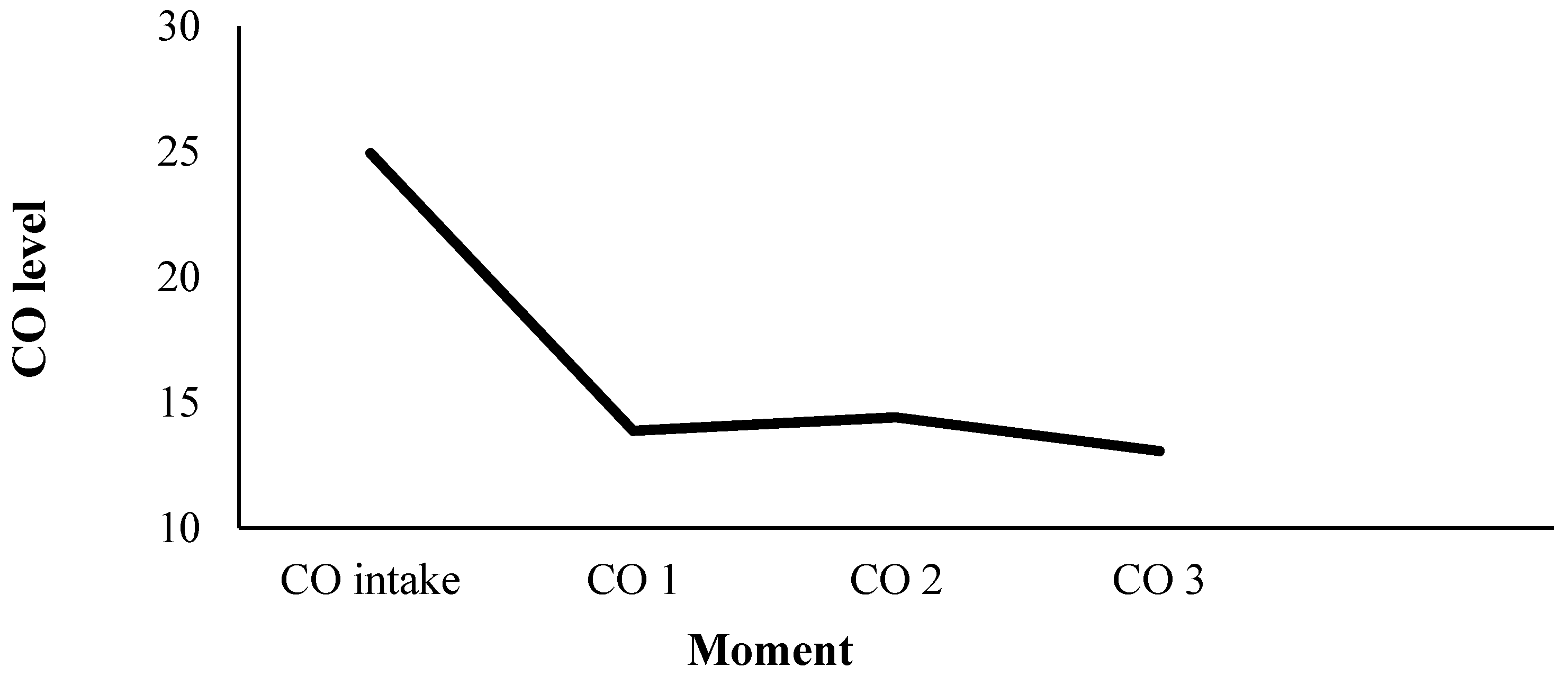
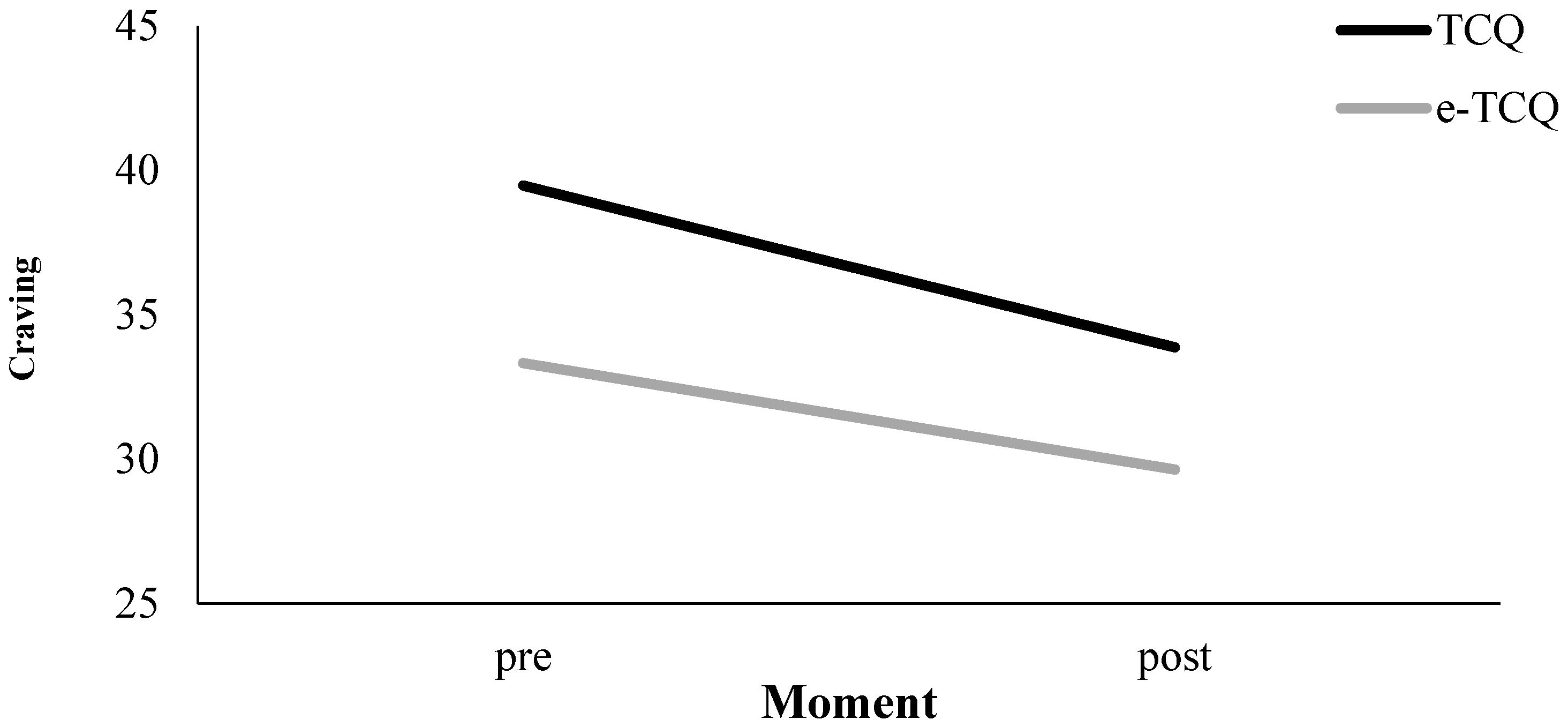
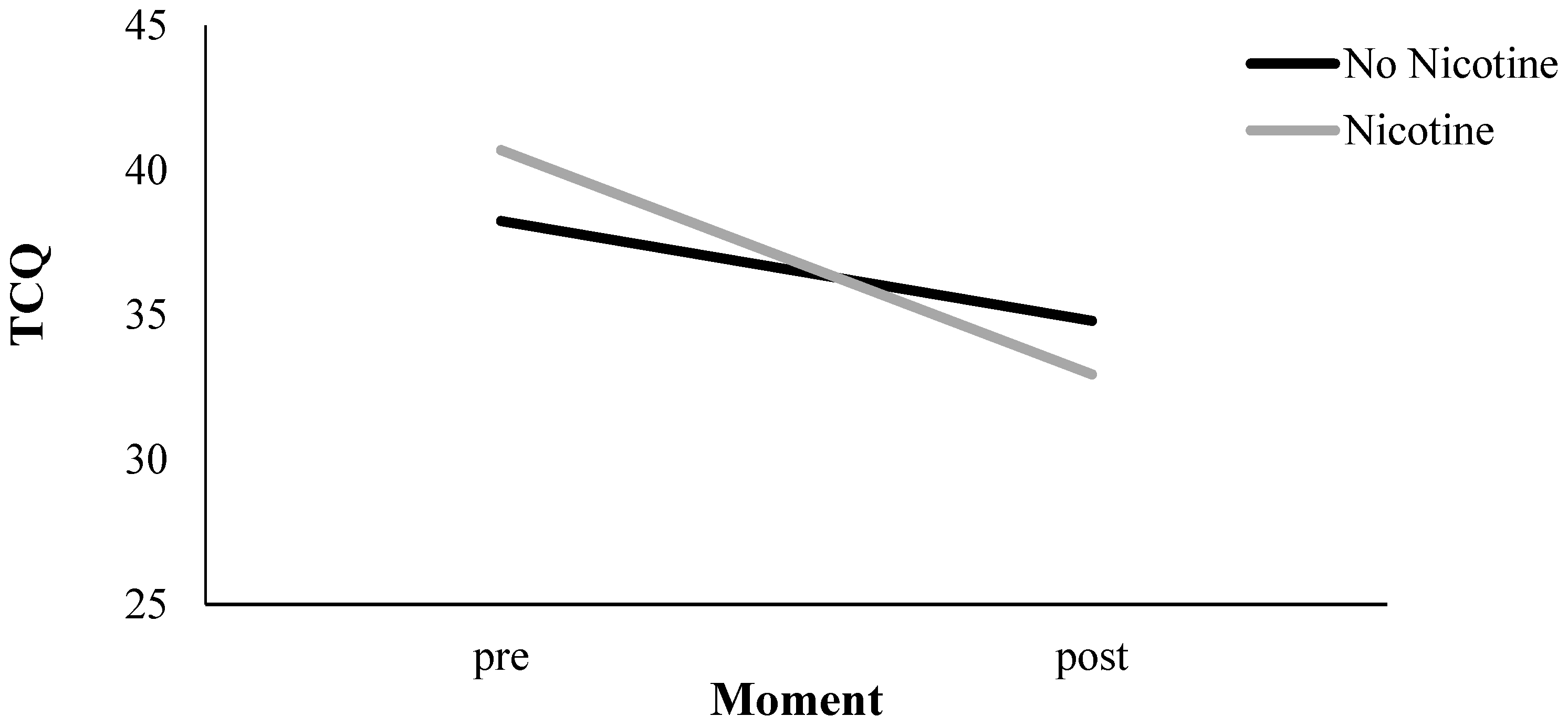
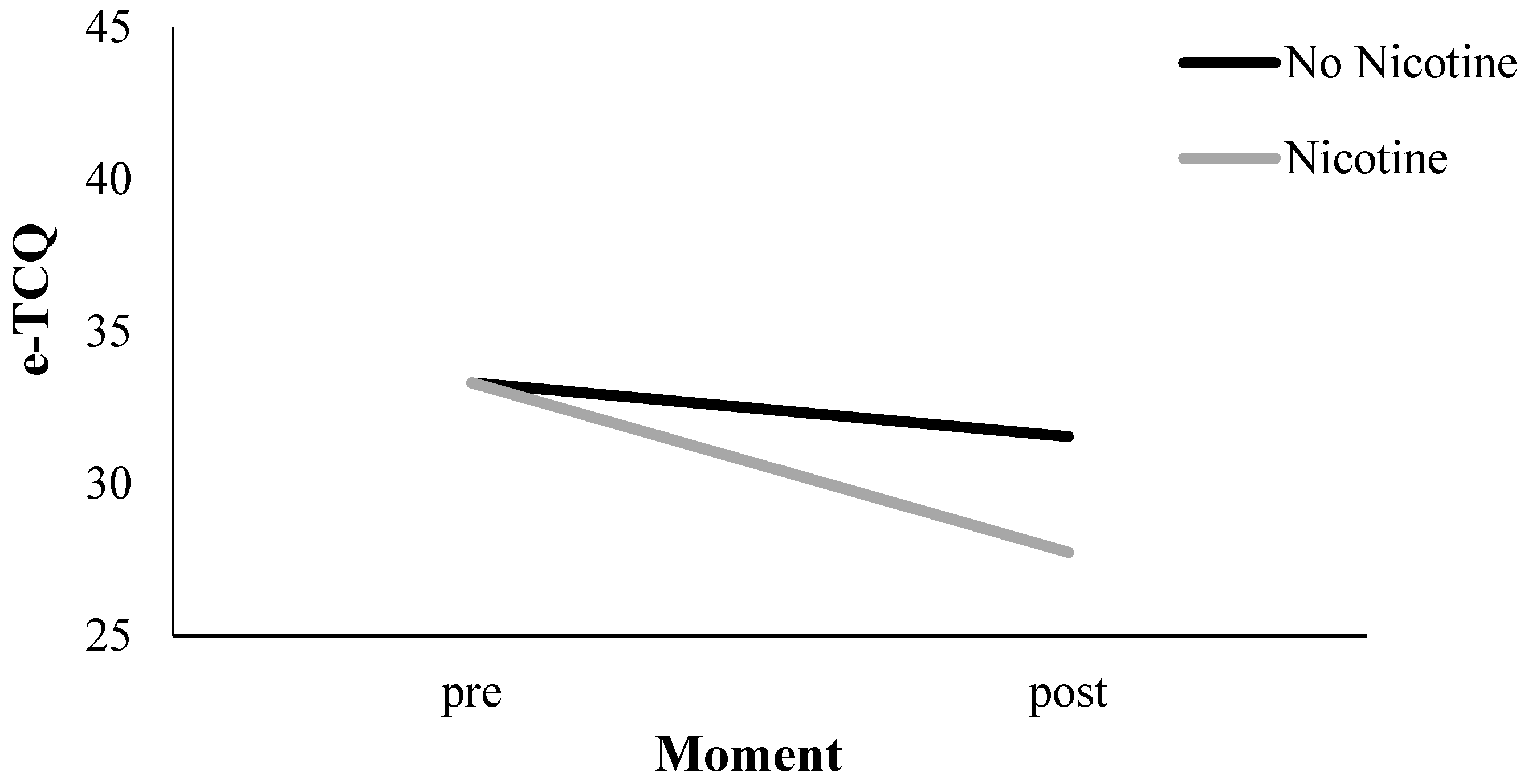
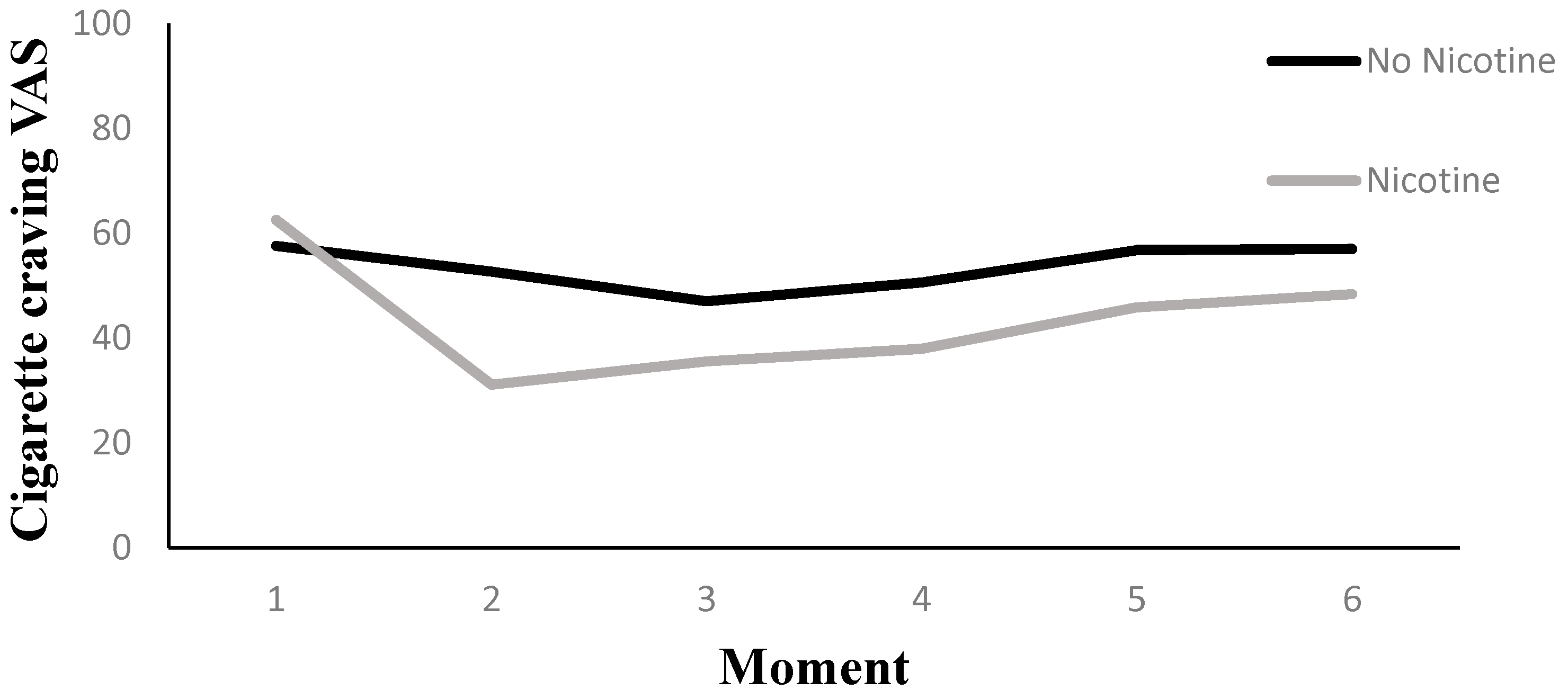
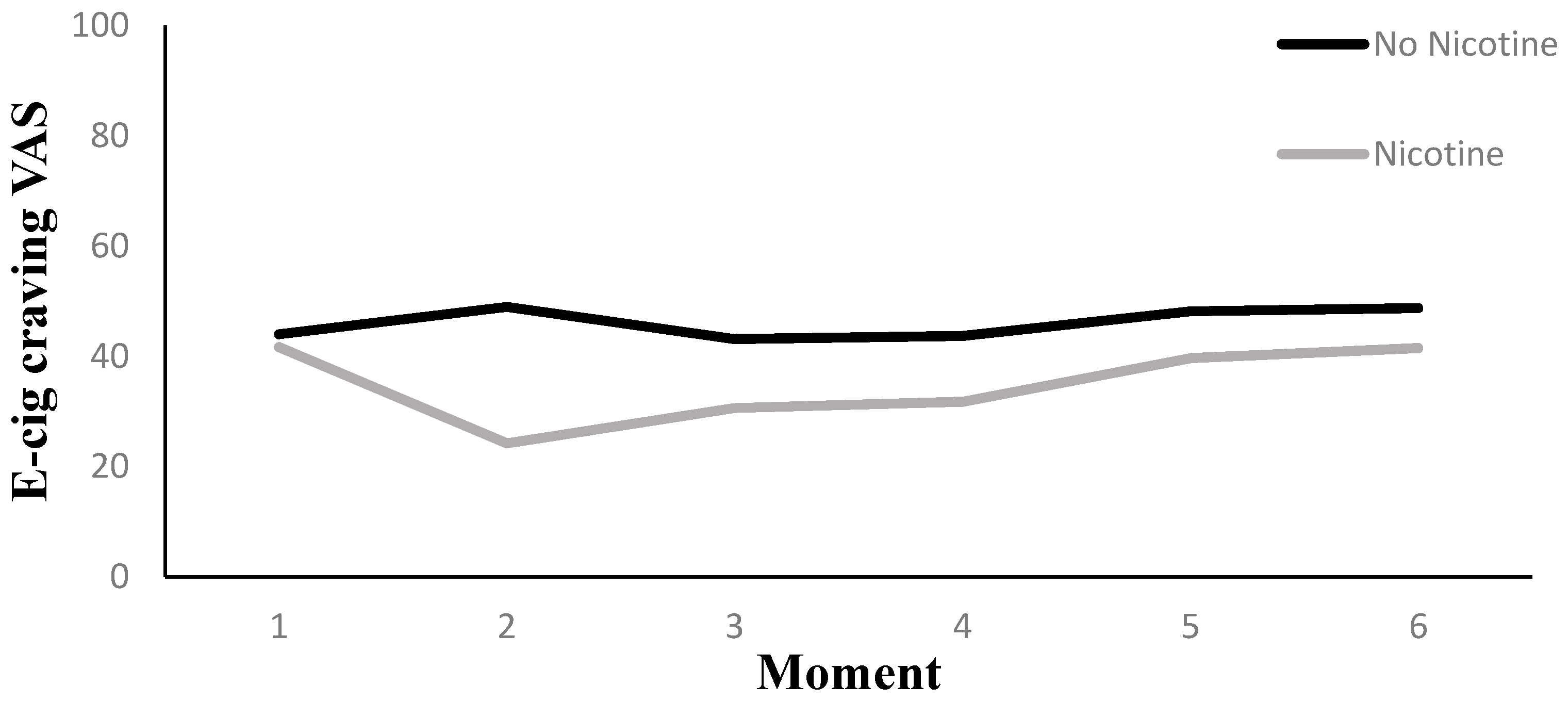

| Outcome | Model | χ2 (df) | p | Condition | Pre vs. Post * | t (df) | p |
|---|---|---|---|---|---|---|---|
| TCQ | Moment | 42.60 (1) | <0.01 | −5.51 | −7.48 (1) | <0.01 | |
| Moment * Nicotine Level | 9.48 (2) | <0.01 | |||||
| Nicotine | −7.75 | −7.83 (1) | <0.01 | ||||
| No-Nicotine | −3.34 | −3.42 (1) | <0.01 | ||||
| Moment * Nicotine Level * Handling | 6.21 (4) | 0.18 | |||||
| Moment * Nicotine Level * Aroma | 3.95 (4) | 0.41 | |||||
| Moment * Nicotine Level * Visual Cues | 4.18 (4) | 0.38 | |||||
| e-TCQ | Moment | 17.06 (1) | <0.01 | −3.60 | −4.38 (1) | <0.01 | |
| Moment * Nicotine Level | 7.17 (2) | <0.05 | |||||
| Nicotine | −5.57 | −4.91 (1) | <0.01 | ||||
| No-Nicotine | −1.68 | −1.50 (1) | 0.14 | ||||
| Moment * Nicotine Level * Handling | 1.40 (4) | 0.85 | |||||
| Moment * Nicotine Level * Aroma | 1.77 (4) | 0.78 | |||||
| Moment * Nicotine Level * Visual Cues | 7.57 (4) | 0.11 |
| Outcome | Index | Model | χ2 (df) | p | Condition | Pre vs. Post1 * | t (df) | p | Pre vs. Post1–5 * | t (df) | p |
|---|---|---|---|---|---|---|---|---|---|---|---|
| VAS | Moment | 95.52 (5) | <0.01 | −19.43 | −8.31 (1) | <0.01 | −14.88 | −7.82 (1) | <0.01 | ||
| Moment * Nicotine Level | 11.01 (6) | 0.09 | |||||||||
| Nicotine | −26.76 | −8.20 (1) | <0.01 | −18.79 | −7.95 (1) | <0.01 | |||||
| No-Nicotine | −12.10 | −3.66 (1) | <0.01 | −10.97 | −3.70 (1) | <0.01 | |||||
| Moment * Nicotine Level * Aroma | 5.99 (5) | 0.31 | |||||||||
| Moment * Nicotine Level * Visual Cues | 6.87 (5) | 0.23 | |||||||||
| Moment * Nicotine Level * Handling | 9.52 (5) | 0.09 | |||||||||
| Moment * Nicotine Level by Manual | 2.49 (6) | 0.87 | |||||||||
| Moment * Nicotine Level by Unipod | 20.52 (6) | <0.01 | |||||||||
| e-VAS | Moment | 37.79 (5) | <0.01 | 11.14 | −4.77 (1) | <0.01 | −7.07 | −3.79 (1) | <0.01 | ||
| Moment * Nicotine Level | 10.35 (6) | 0.11 | |||||||||
| Nicotine | −15.42 | −4.70 (1) | <0.01 | −8.40 | −3.55 (1) | <0.01 | |||||
| No-Nicotine | −6.86 | −2.10 (1) | <0.01 | −5.75 | −2.00 (1) | <0.05 | |||||
| Moment * Nicotine Level * Aroma | 3.73 (5) | 0.59 | |||||||||
| Moment * Nicotine Level * Visual Cues | 9.95 (5) | 0.08 | |||||||||
| Moment * Nicotine Level by Blind | 4.48 (6) | 0.61 | |||||||||
| Moment * Nicotine Level by Unrestricted | 15.75 (6) | <0.05 | |||||||||
| Moment * Nicotine Level * Handling | 9.62 (5) | 0.09 | |||||||||
| Moment * Nicotine Level at Manual | 8.76 (6) | 0.19 | |||||||||
| Moment * Nicotine Level at Unipod | 11.92 (6) | 0.06 | |||||||||
© 2017 by the authors. Licensee MDPI, Basel, Switzerland. This article is an open access article distributed under the terms and conditions of the Creative Commons Attribution (CC BY) license ( http://creativecommons.org/licenses/by/4.0/).
Share and Cite
Van Heel, M.; Van Gucht, D.; Vanbrabant, K.; Baeyens, F. The Importance of Conditioned Stimuli in Cigarette and E-Cigarette Craving Reduction by E-Cigarettes. Int. J. Environ. Res. Public Health 2017, 14, 193. https://doi.org/10.3390/ijerph14020193
Van Heel M, Van Gucht D, Vanbrabant K, Baeyens F. The Importance of Conditioned Stimuli in Cigarette and E-Cigarette Craving Reduction by E-Cigarettes. International Journal of Environmental Research and Public Health. 2017; 14(2):193. https://doi.org/10.3390/ijerph14020193
Chicago/Turabian StyleVan Heel, Martijn, Dinska Van Gucht, Koen Vanbrabant, and Frank Baeyens. 2017. "The Importance of Conditioned Stimuli in Cigarette and E-Cigarette Craving Reduction by E-Cigarettes" International Journal of Environmental Research and Public Health 14, no. 2: 193. https://doi.org/10.3390/ijerph14020193






